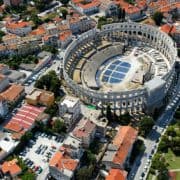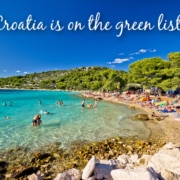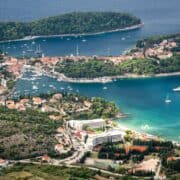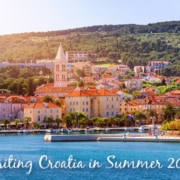Coronavirus in Croatia Autumn 2021 Update
Many had hoped that by this time in 2021 – almost a year after the first vaccinations were being distributed across the world – coronavirus would be a relatively distant memory and we’d be back to normality. Whilst many of us are seeing some semblance of normality in our day to day lives – with lockdowns not currently in operation in many places, travel, entertainment, work, education and more all possible – unfortunately case numbers remain high in many countries. This is certainly true in Croatia where in early November, the country recorded its highest ever daily case number today (over 7,000 new cases) ever in the whole pandemic. As such, we thought we would publish a Coronavirus in Croatia Autumn 2021 post to update you all on case numbers, the current vaccination rate and any new restrictions that come into effect.
Unfortunately, the vaccination rate in Croatia has been quite low compared to other European countries with the country having about the third or fourth lowest vaccination rate in the EU. This may well be one reason why case numbers have now jumped up some considerably this autumn.

Coronavirus in Croatia Autumn 2021
Latest updateToday, 20th December 2021, 367 new cases have been announced. There are presently 19,570 active cases in the country. Most active cases are currently located in the City of Zagreb (4,663 active cases), followed by Split-Dalmatia county (2,566 active cases) and then Zagreb county (1,668 active cases). Sadly, there have been 12,043 deaths in total in Croatia since the pandemic began.
UpdatedToday, 16th December 2021, 3,765 new cases have been announced. There are presently 24,082 active cases in the country. Most active cases are currently located in the City of Zagreb (6,086 active cases), followed by Split-Dalmatia county (2,980 active cases) and then Zagreb county (2,139 active cases). Sadly, there have been 11,825 deaths in total in Croatia since the pandemic began.
UpdatedToday, 13th December 2021, 453 new cases have been announced. There are presently 21,581 active cases in the country. Most active cases are currently located in the City of Zagreb (5,732 active cases), followed by Split-Dalmatia county (2,308 active cases) and then Zagreb county (2,011 active cases). Sadly, there have been 11,666 deaths in total in Croatia since the pandemic began.
UpdatedToday, 10th December 2021, 3,797 new cases have been announced. There are presently 26,824 active cases in the country. Most active cases are currently located in the City of Zagreb (7,127 active cases), followed by Split-Dalmatia county (2,747 active cases) and then Zagreb county (2,611 active cases). Sadly, there have been 11,516 deaths in total in Croatia since the pandemic began.
UpdatedToday, 6th December 2021, 728 new cases have been announced. There are presently 25,567 active cases in the country. Most active cases are currently located in the City of Zagreb (7,069 active cases), followed by Zagreb county (2,655 active cases) and then Split-Dalmatia county (2,445 active cases). Sadly, there have been 11,269 deaths in total in Croatia since the pandemic began.
UpdatedToday, 2nd December 2021, 5,341 new cases have been announced. There are presently 32,603 active cases in the country. Most active cases are currently located in the City of Zagreb (8,569 active cases), followed by Split-Dalmatia county (3,435 active cases) and then Zagreb county (3,191 active cases). Sadly, there have been 10,826 deaths in total in Croatia since the pandemic began.
UpdatedToday, 29th November 2021, 1,031 new cases have been announced. There are presently 29,891 active cases in the country. Most active cases are currently located in the City of Zagreb (7,869 active cases), followed by Split-Dalmatia county (3,023 active cases) and then Zagreb county (2,839 active cases). Sadly, there have been 10,826 deaths in total in Croatia since the pandemic began.
UpdatedToday, 25th November 2021, 6,246 new cases have been announced. There are presently 34,953 active cases in the country. Most active cases are currently located in the City of Zagreb (8,915 active cases), followed by Split-Dalmatia county (3,692 active cases) and then Zagreb county (3,181 active cases). Sadly, there have been 10,569 deaths in total in Croatia since the pandemic began.
UpdatedToday, 22nd November 2021, 1,327 new cases have been announced. There are presently 29,725 active cases in the country. Most active cases are currently located in the City of Zagreb (7,460 active cases), followed by Split-Dalmatia county (3,000 active cases) and then Zagreb county (2,630 active cases). Sadly, there have been 10,376 deaths in total in Croatia since the pandemic began.
UpdatedToday, 18th November 2021, 7,270 new cases have been announced. There are presently 39,034 active cases in the country. Most active cases are currently located in the City of Zagreb (9,438 active cases), followed by Split-Dalmatia county (4,306 active cases) and thenPrimorje-Gorski Kotar county (3,534 active cases). Sadly, there have been 10,113 deaths in total in Croatia since the pandemic began.
UpdatedToday, 15th November 2021, 1,135 new cases have been announced. There are presently 34,062 active cases in the country. Most active cases are currently located in the City of Zagreb (8,270 active cases), followed by Split-Dalmatia county (3,765 active cases) and thenPrimorje-Gorski Kotar county (2,985 active cases). Sadly, there have been 9,936 deaths in total in Croatia since the pandemic began.
UpdatedToday, 8th November 2021, 1,242 new cases have been announced. (As it’s a Monday, case numbers are always lower than maybe expected due to the weekend.) There are presently 29,265 active cases in the country. Most active cases are currently located in the City of Zagreb (7,258 active cases), followed by Split-Dalmatia county (3,257 active cases) and thenPrimorje-Gorski Kotar county (2,692 active cases). Sadly, there have been 9,546 deaths in total in Croatia since the pandemic began.
News and data on coronavirus cases in Croatia Autumn 2021
The Koronavirus.hr website (in English) publishes daily updates about new case numbers every morning. That same website also displays a map that shows active cases by county, as well as the total number of cases since the pandemic began.
To compare Croatia’s figures to the rest of the EU, take a look at the website of the European Centre for Disease Prevention and Control (ECDC). This website shows the 14-day cumulative number of cases per 100,000 for all EU countries. You can also take a look at the ECDC Map which shows a colour-coded map of Europe based on test positivity rates. (This map is updated every Thursday.)
Coronavirus vaccinations in Croatia Autumn 2021
Latest update As of 19th December, 2,242,791 people in Croatia have received the first vaccine dose, and 2,090,818 have received both doses or a single dose vaccine. That means that 65.87% of the adult population (or 55.27% of the total population) of Croatia have been vaccinated.
Updated As of 12th December, 2,227,358 people in Croatia have received the first vaccine dose, and 2,039,788 have received both doses or a single dose vaccine. That means that 65.42% of the adult population (or 54.89% of the total population) of Croatia have been vaccinated.
Updated As of 5th December, 2,207,786 people in Croatia have received the first vaccine dose, and 1,981,397 have received both doses or a single dose vaccine. That means that 64.89% of the adult population (or 54.4% of the total population) of Croatia have been vaccinated.
Updated As of 28th November, 2,176,068 people in Croatia have received the first vaccine dose, and 1,931,878 have received both doses of a two-dose vaccine. That means that 63.9% of the adult population (or 53.6% of the total population) of Croatia have been vaccinated.
Updated As of 22nd November, 2,125,514 people in Croatia have received the first vaccine dose, and 1,896,361 have received both doses of a two-dose vaccine. That means that 62.5% of the adult population (or 52.3% of the total population) of Croatia have been vaccinated.
Updated As of 15th November, 2,048,628 people in Croatia have received the first vaccine dose, and 1,859,418 have received both doses of a two-dose vaccine. That means that 60% of the adult population (or 50% of the total population) of Croatia have been vaccinated.
Updated As of 7th November, 1,948,738 people in Croatia have received the first vaccine dose, and 1,820,138 have received both doses of a two-dose vaccine. (An additional 121,725 people have received a single dose vaccine.) That means 58% of the adult population of Croatia have received one dose, and 58% have received both doses.
You can track vaccination statistics in Croatia on the Croatian Institute of Public Health website – they now have an interactive map which show vaccination rates by municipality (in Croatian). You can also see the rate of vaccination in Croatia compared to other European countries on the Our World in Health website.
Current Restrictions in Croatia
Travel Restrictions
Latest update As of 26th November 2021, due to the new omicron variant of coronavirus, there is a complete ban on passengers entering Croatia from the following countries (or if you have been in one of the following countries in the previous 14 days): South Africa, Botswana, Eswatini, Lesotho, Namibia, Zimbabwe and Hong Kong. If you are a Croatian citizen or long-term resident, then you are permitted to enter Croatia but you must quarantine for 14 days. This measure is in effect until 15th December 2021.
Restrictions in Croatia
Some new restrictions have come into effect on 6th November 2021. These include:
- Indoor events of more than 50 people are prohibited, unless attended by people with a covid certificate – but masks and social distancing are mandatory
- Outdoor events of more than 100 people can be organised if all participants have a covid certificate
- Events must finished by midnight (cinema screenings can run until 2am)
- Weddings are permitted to run until 2am, providing everyone attending has a covid certificate
- Congresses and conferences are permitted to be held, providing everyone attending has a covid certificate and masks and social distancing are mandatory
- Indoor sports gatherings are permitted providing all those attending have a covid certificate and wears masks
- Outdoor sports gatherings are permitted; covid certificates are again required but masks are not necessary
- School students in some years must wear masks when moving around the school
From 16th November 2021, all workers and visitors to government institutions must present an EU Digital Covid Certificate or be tested.
The use of covid certificates may also be implemented for venues such as cafes, restaurants and gyms should the number of new cases increase.










